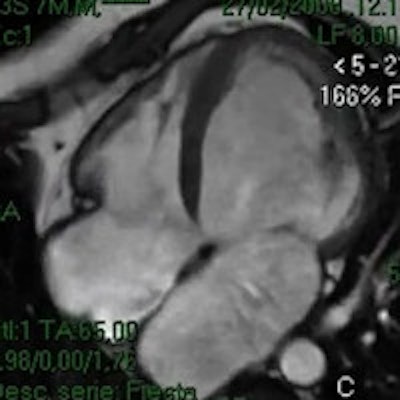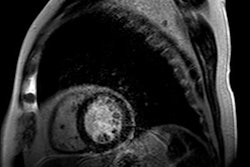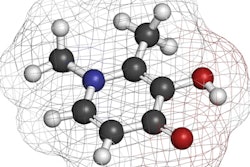
The first thorough accounting of cardiac MR (CMR) use in Italy found that systems are used in a wide variety of examinations -- most relating to inflammatory disease and cardiomyopathies -- and most yield results that have a strong impact on patient management, according to an article published online on 19 October by the European Journal of Radiology.
In a survey that encompassed more than 3,000 patients scanned at 40 centers across Italy over a period of six months, investigators found that nearly all machines are limited to 1.5-tesla, nearly all cardiac scans are performed with contrast, but without pharmacologic stress, and more than half of all cases were performed for the workup of heart disease and cardiomyopathies followed by the assessment of myocardial viability in 7% of patients, and acute infarction in 6%.
"CMR is performed in a large number of centers in Italy with relevant impact on clinical decision-making and high safety profile," wrote Dr. Marco Francone from the University of Rome La Sapienza, Dr. Ernesto Di Cesare from the University of L'Aquila, Dr. Filippo Cademartiri from Giovanni XXIII Hospital, Monastier di Treviso, and colleagues from centers throughout the country.
 |
Importantly, the study showed a high number of exams performed by radiologists in Italy -- in numbers larger than expected, with exams well distributed throughout the country though more prevalent in northern centers, commented Di Cesare, an associate professor of radiology and cardiology, in an email to AuntMinnieEurope.com. On the other hand, the low rate of pharmacologic stress exams was "a negative surprise," he noted. This probably reflects the low confidence of the radiological community in performing the exams compared with cardiologists, and the solution is to team up with cardiologists to formally train radiologists in the safe use of pharmacologic agents and performance of stress CMR exams, Di Cesare wrote.
In recent years, CMR has evolved from a research tool to a comprehensive and safe imaging modality covering a broad spectrum of clinical indications in more and more facilities, Francone and colleagues wrote. But most of the information regarding its use comes from a few large clinical trials, which doesn't represent typical day-to-day use in the clinical setting.
Before this study was undertaken, the only available register to date was EuroCMR, which was recently completed with 27,000 patients, most of whom were treated in CMR-dedicated cardiological centers. This registry demonstrates CMR's growth from a niche modality performed in a few referral centers to a valuable clinical tool to solve a wide range of diagnostic problems, the authors wrote.
The Italian registry of CMR takes a broader view. It is an open access study set up to offer a national overview of CMR utilization "offering a more 'radiological' point of view of its current clinical role in daily practice," the group wrote. Promoted by the Italian Radiological Society, SIRM (Società Italiana di Radiologia Medica), it involved 40 centers and multiple vendors, and sought to "evaluate clinical indications, spectrum of acquisition protocols, impact on clinical decision-making, and safety profile of CMR," according to the study team.
They collected data between January and June 2011 from a population of 3,376 consecutive patients 47.2 ± 19 years examined in one of the 40 centers, each of which was responsible for its own data integrity, and for tailoring its own acquisition protocols. Each case report submitted for the registry included clinical indication, protocol information, and appropriateness criteria.
"Referral physicians were not required to exhibit any specific subspecialty based certificate of competency in CMR imaging as the aim of present registry was to provide a realistic 'snapshot' of CMR utilization in Italy, without limiting patient's enrollment only to most-experienced national groups," the authors wrote.
The study team carefully recorded any adverse events after the exam. Incidents were scored as mild, moderate, or severe using criteria adapted from Dorfman et al. Image quality was scored on a five-point scale with five being excellent. Finally, the researchers scored the results of the exam based on the main clinical question, and assessed the clinical impact of the exam on patient management.
Inflammatory disease and cardiomyopathies
Results in 3,376 patients showed an average 84 patients per center, with a mean age of 47.2 years. Two-thirds of patients were men. The mean body mass index (BMI) was 24.8 ± 2.2 (range, 21.6-27.4).
Exams were defined as urgent in 6.5% of patients and elective in 91.6%, with no information available in 1.8%. Urgent exams were mostly required for the evaluation of acute patients, including myocarditis and acute infarct in 70% or following a surgical procedure in 21%. Sixty-one percent of exams were performed on outpatients, 7% in day hospitals, 31% on hospitalized patients, and nonspecified in 23 (1%).
A majority (55.7%) of exams were performed to work up inflammatory heart disease and cardiomyopathies (CMP), followed by assessment of myocardial viability (6.9%) and acute infarction (5.9%), the authors wrote -- a remarkable difference from the EuroCMR Registry, which had far more ischemia and suspected myocarditis and cardiomyopathies, they noted.
"Rather than a single predominant clinical request, there were five substantially balanced most frequent indications in our series, ranging between 11.2% and 8.7% of cases and represented (in order) by ARVC [arrhythmogenic right ventricular cardiomyopathy], iron overload quantification, acute myocarditis, hypertrophic, and dilated CMPs," they wrote.
The most frequent clinical indications were ARVC (11.2%), iron overload quantification (9.9%), acute myocarditis (9.8%), hypertrophic CMPs (9.2%), and dilated CMPs, 8.7%.
The vast majority of exams were performed in 1.5-tesla systems (96.5%), followed by 3-tesla (2.7%) and 1-tesla systems (0.8%), with contrast agent administered in 84.8% of exams.
Image quality was reported to be excellent or good in 82% of cases.
Commenting on the relative lack of high-field MRI, "both the higher scanners' costs and technical challenges (field homogeneity reduction with increased susceptibility artifacts and radiofrequency -- induced power deposition) associated with high-field systems are still perceived as major drawbacks by most centers limiting their diffusion and utilization in the territory only to few research sites," the authors wrote.
Pharmacologic exams (using dipyridamole, adenosine, or dobutamine) were conducted in just 3.0%, the study team wrote.
"The low prevalence of stress exams in our patient's population highlights an important feature of present registry, which mainly reports activity performed in radiological units as compared to the prominent clinical/cardiological background of the EuroCMR," Francone and colleagues wrote. "This observation accounts for the different attitude of cardiologists toward use of stress imaging for the evaluation of CAD and a probably deeper clinical comprehension of the added value of MR in this clinical setting as compared to echocardiography or SPECT."
Acquisition time ranged between three to 150 minutes with an average scanning duration of 43 ± 13 minutes per exam overall -- or 35 minutes for noncontrast, 44 minutes for rest, and 54 minutes on average for stress. Exams performed with contrast composed of 84.8% of all exams.
The exams were performed safely, with only 30 (0.9%) adverse mild or moderate clinical events that were noted during or immediately after the procedure, and there was no occurrence of severe reactions or death. Four of the events were related to pharmacologic stress exams, and the low number of these probably kept the total number of adverse reactions low, the group wrote.
"The limited incidence and low severity of adverse clinical events observed in our registry confirm that CMR is a safe examination with a low rate of acute contrast-related adverse reactions, which was similar in our patient's database to literature data," the authors wrote.
Stress exams for coronary artery disease yielded the highest impact on patient management (68% of cases), followed by the assessment and quantification of iron overload (64.0%), suspected acute myocarditis (60% of cases), and dilated cardiomiopathy (54.0%). On the other hand, 61.1% of exams for takotsubo cardiomyopathy and 52.3% of exams for suspected acute myocardial infarction had no impact on the clinical and diagnostic workup.
Corresponding to geographic difference in the availability of MRI systems, by far more patients were imaged in the north (46.3%), followed by central (36.8%), and southern Italy and the islands (16.9%).
| Top 10 indications for CMR and imaging results | ||||
| Clinical indication | Prevalence | Negative | Positive | Nondiagnostic |
| Arrhythmogenic right ventricular cardiomyopathy (ARVC) | 11.2 | 72.0 | 23.1 | 2.6 |
| Iron overload | 9.9 | 14.7 | 84.3 | 0.6 |
| Acute myocarditis | 9.8 | 31.1 | 67.1 | 0.9 |
| Hypertrophic CMP | 9.2 | 21 | 75.4 | 2.0 |
| Dilated CMP | 8.7 | 16.0 | 78.0 | 3.0 |
| Viability | 6.9 | 17.7 | 78.9 | 0.7 |
| Acute myocardial infarction | 5.9 | 14.0 | 84.2 | 0.9 |
| Ischemia/stress | 3.0 | 47.0 | 49.0 | - |
| Noncompaction | 3.0 | 45.7 | 51.0 | 1.1 |
| Myocardial storage disease | 2.2 | 42.0 | 56.0 | 0.4 |
The high prevalence of iron overload as an indication is probably a reflection of the epidemiology of beta thalassemia in Italy, which is endemic in specific areas of the country, the group noted. Similarly, a high prevalence of suspected acute myocarditis (9.8%) is probably a reflection of the high sensitivity of CMR to detect signs of active inflammation represented by edema, capillary leakage, and fibrosis and necrosis.
"Despite the low incidence of disease, we had an unexpected prevalence of 23.0% positive cases in our patient population representing an unlikely false-positive rate likely attributable to the trend to overreading and overdiagnose ARVD [arrhythmogenic right ventricular dysplasia] in less experienced operators," the group wrote.
Interestingly, 80.1% of exams were read by radiologists rather than cardiologists -- a clear departure from the EuroCMR data in which radiologists read just 2.6% of the cases. And 27% of exams were read by a combined team of a radiologist and a cardiologist. The authors cited "specialty bias" in selecting the centers for the high number of radiologists performing the exams.
Among the many limitations of the study was that the centers' expertise was not a consideration in their selection, so some centers may have misdiagnosed or overdiagnosed ARVD, for example, skewing the numbers, Di Cesare wrote. In addition, the study design makes it difficult to identify specific training needs.
"Further research focus of CMR registries would probably require systematic clinical follow-up of patients enrolled in order to analyze mid- and long-term implications of CMR findings providing wider comprehension of its clinical role in the complex scenario of cardiovascular diseases," Francone and colleagues wrote.



















